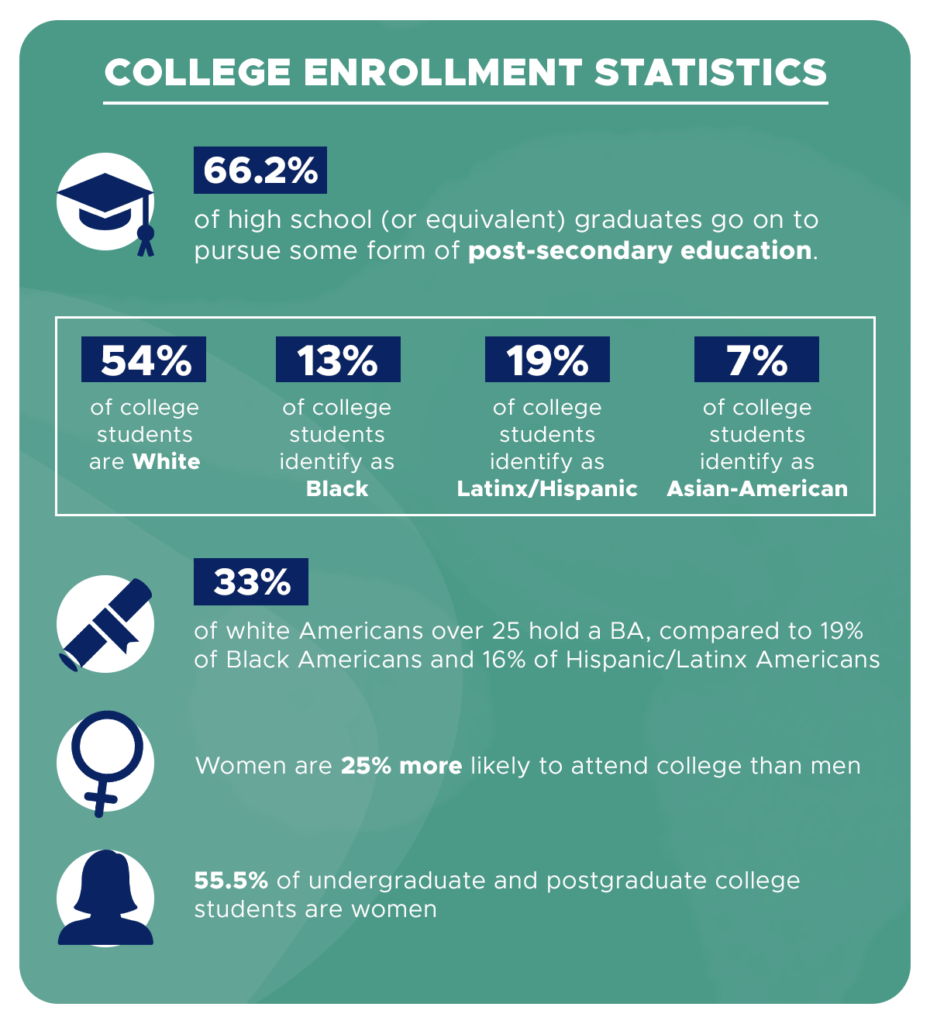
College Enrollment Guide
So you’re past applications and have moved on to the exciting process of college enrollment! Well, congratulations. Choosing what school you’re going to attend is an exciting decision. But, it can also be a confusing one. What exactly is the university enrollment process? What do you have to do in order to secure a place at your dream school?
As you completed the application process, you likely noticed the undergraduate enrollment at each school, i.e. the number of students in attendance. In fact, college enrollment was probably a large factor in your decision process. Whether you chose schools with higher or lower university enrollment, you now need to navigate the somewhat confusing prospect of enrollment in college. But, don’t worry! You’re not alone in the university enrollment process.
If you’re wondering how to get through college enrollment, you’re in the right place. At CollegeAdvisor.com, we understand how confusing the college enrollment process can be. In this guide to college enrollment, we’ll explain what college enrollment means, look at how to enroll in college, break down various trends in university enrollment, check out some of the universities with the largest college enrollment, see some college enrollment statistics by university, list some college enrollment by race and gender facts, and discuss how you can complete your higher education enrollment process.
What is “college enrollment”?
All this talk of college enrollment and university enrollment, but what does enrollment in college actually mean?
College enrollment is the process of deciding where you will attend a university. Enrollment in college means that you accept admission to that school and commit to attending. While it may seem simple, figuring out how to enroll in college can be a confusing process.
When exactly should you start worrying about enrollment in college? After you’ve received acceptance to your top schools, you’ll want to start thinking about which school you want to choose. Then, you’ll continue the university enrollment process.
The first step in college enrollment is deciding on your school. Once you’ve done that, you’ll want to look at that institution’s specific university enrollment guidelines.
National College Enrollment deadline: May 1st
The national college enrollment deadline for accepted students is May 1st. However, college enrollment when you are placed on the waitlist is slightly different. Waitlisted students won’t find out a final decision until after May 1st after the majority of accepted students will have already started the college enrollment process. Waitlisted students may not hear about their acceptance until right before the fall semester, which can make the higher education enrollment process a bit more stressful. If you’re waitlisted, make sure you have a backup plan, just in case.
How to enroll in college?
Now that you know the definition of college enrollment or university enrollment, let’s review some of the details on how to enroll in college. Higher education enrollment protocols will vary based on the university. After the national deadline of May 1st, all students must commit to a school and send a college enrollment deposit to guarantee their place. This is technically when enrollment in college begins.
However, there’s much more to enrollment in college than just that first step. You’ll want to review your acceptance letter or check out your university’s admission site for specifics. This will ensure you don’t miss anything about how to enroll in college at your chosen school. Often, you’ll complete college enrollment through the university’s portal, which you should be able to access online. The college enrollment process will be different for each university though.
For example, University of Florida enrollment is mapped out step-by-step on their admissions site so that students don’t miss any important university enrollment deadlines. This simplifies the “how to enroll in college” process. Basically, follow the school’s checklist. Generally, the process will include registering for the university-specific portal. This portal should detail the college enrollment process with university-specific steps to complete.
Is college enrollment binding?
Generally, college enrollment isn’t binding. However, once students start the university enrollment process by sending in that deposit by May 1st, that money is usually non-refundable. You aren’t, however, contractually obligated to attend that school in the fall. That being said, if you’re sending in a deposit, barring an emergency situation, you should commit to enrollment in college at that school.
When is higher education enrollment binding?
When it’s specifically and explicitly stated by the university. In some cases, students who apply to Early Decision enter a binding agreement stating that if accepted, they will attend. If that is the case for certain schools, students should only apply Early Decision if they are positive that they want to continue the college enrollment process at that school.

Understanding college enrollment
College enrollment is the process of committing to one school and completing all the tasks that the school requires for university enrollment. To figure out the higher education enrollment process for your school, check out their admissions site. You’ll most likely have to register with their school’s online portal. There, each school will break down the tasks for enrollment, including deadlines. That way, the question of “how to enroll in college” will become a simple checklist.
During college enrollment, you should keep several things in mind. For example, while the first step of university enrollment isn’t usually binding, it is nonrefundable. So you want to be positive that this is the school you want to attend. Have you done your research on the college where you’re enrolling? Do you know this school is the right school for you? Have you confirmed any financial aid or scholarship funding? Are you positive you want to continue with the higher education enrollment process at this university? These are some of the first things you should be answering early in the college enrollment process.
Pay attention to deadlines
Throughout university enrollment, make sure to meet your deadlines. If you’re wondering about how to enroll in college, then you may have also heard about college enrollment caps. Universities need to limit the number of spaces available in order to avoid overcrowding and to keep the student-to-faculty ratios accurate. These college enrollment caps aren’t just for undergraduate enrollment in general; they may also be for specific programs or classes. These caps will play a part in the college enrollment statistics by university, as universities can only accept a certain number of applicants yearly.
Higher education enrollment caps affect admissions and college enrollment statistics by university. However, these college enrollment caps shouldn’t be at the forefront of your mind during the application process. Of course, it’s good to know admissions rates, and college enrollment and program-specific caps. Still, you should spend your time trying to make your applications as strong as possible. Include a mix of different schools so you don’t just apply to schools with highly selective university enrollment.
So, how to enroll in college shouldn’t be at the top of your mind when completing your applications. Focus on building a solid application narrative and candidate profile. Once your acceptance letters come, then start thinking about how to enroll in college.
College enrollment case study: UCLA enrollment

To make things a little clearer, let’s check out UCLA enrollment specifically. When it comes to UCLA enrollment, and that of many other large public institutions, college enrollment differs based on your state of residence. The college enrollment caps will be different for in-state students and out-of-state students, as is the case in UCLA enrollment. Just as the tuition is different for out-of-state residents, the UCLA enrollment cap is as well, accepting the majority of their applicants from California. UCLA enrollment is highly competitive, with an acceptance rate of 11% for the fall 2021 semester.
If UCLA is one of your top choices, check out the UCLA enrollment steps for newly admitted students here. Remember, don’t stress too much about the UCLA enrollment process until you’re sure you want to attend.
College enrollment statistics by university and broader college enrollment trends have been a topic of interest in recent years. One shift in college enrollment trends has experts worried. Enrollment in college has been declining for years, with the pandemic taking a huge negative toll on college enrollment trends. We’ll discuss these college enrollment trends in greater depth later in this article, for now let’s review some college enrollment statistics for specific schools.
College enrollment statistics
Understanding college enrollment statistics and college enrollment statistics by university can give you an edge while planning your college application process. It’s important to have a variety of different universities with different college enrollment trends when applying. Knowing how selective university enrollment is will also help you create your college list. But don’t let college enrollment statistics by university be the sole factor in applying to a school. After all, it’s a holistic process.
College enrollment statistics show that overall higher education enrollment is at a decline. Post-secondary enrollment has fallen 4.1% or by 685,000 students in recent years. Public institution enrollment dropped by 5% and the total undergraduate college enrollment has fallen by 1.4 million students since 2019.
As we will discuss, college enrollment trends seem to be the same across the nation. These show a clear college enrollment decline. However, college enrollment statistics look slightly different depending on the university.
For example, some experts argued that Harvard enrollment, Stanford enrollment, Duke enrollment, NYU enrollment, Cornell enrollment, and Yale enrollment haven’t seen too drastic of a change in undergraduate enrollment over the years. However, college enrollment at larger state institutions has varied more. This is the case for the Texas A&M enrollment, University of Texas enrollment, Ohio State enrollment, University of Illinois enrollment, University of Florida enrollment, and USC enrollment. While college enrollment numbers have shifted from year to year, this shift looks different at different schools
College enrollment by university

Here are some college enrollment statistics for specific schools:
Harvard enrollment
Harvard undergraduate enrollment was at 5,222 for fall 2020. However, Harvard enrollment remains one of the most difficult and most competitive to join. In fact, Harvard enrollment broke records by accepting only 3.19% of applicants to the 2026 class, down from 3.43% in the previous year.
Stanford enrollment
The incoming freshman Stanford enrollment was at about 2,000 for the 2025 class, slightly up from usual. The total undergraduate enrollment is about 7,600. Stanford enrollment is highly competitive.
Duke enrollment
In Fall 2020, Duke enrollment was at about 6,700, keeping it closer to the Harvard enrollment. Duke is a highly competitive university with an acceptance rate of about 7.6%. This makes Duke enrollment a goal sought after by many but obtained by few.
NYU enrollment
NYU enrollment is larger than the Stanford enrollment and Duke enrollment, as well as the Harvard enrollment. The NYU enrollment is about 25,000. While NYU enrollment may be higher than the Stanford enrollment and Duke enrollment, it is still a competitive university with an acceptance rate of 16.2%.
Cornell enrollment
Cornell enrollment is at about 15,000. With an acceptance rate of 10.85%, this is another highly competitive university. Cornell enrollment for freshmen was at about 3,200 for the 2023 class—similar to the Stanford enrollment.
Yale enrollment
If you’re wondering about Cornell enrollment, Harvard enrollment, and Duke enrollment, then Yale enrollment probably isn’t far behind in the university enrollment search. Yale enrollment is 6,494 and, you guessed it, it’s another highly competitive school with an acceptance rate of 6.6%. Yale enrollment has recently broken records with its highest number of applicants yet.
Texas A&M enrollment
Veering away from the better-known Ivies, let’s look at Texas A&M enrollment. The acceptance rate is 57.8% and the Texas A&M enrollment is about 47,000. Texas A&M enrollment numbers break the general enrollment trends nationwide with a 3.1% increase in college enrollment from the previous year.
University of Texas enrollment
University of Texas enrollment seems high with an undergraduate enrollment of 38,000. However, UT retains a competitive acceptance rate of about 32%. University of Texas enrollment hasn’t been affected like many other college enrollments in Texas which are suffering a decline. In fact, University of Texas enrollment is actually up.
Ohio State enrollment
OSU enrollment was at 61,000 in the fall of 2020, making the Ohio state enrollment one of the largest college enrollment populations in the nation. The acceptance rate is 68%, making it seem less competitive than others on this list.
University of Illinois enrollment
The University of Illinois enrollment is 32,700 and the acceptance rate is 59%. The large University of Illinois enrollment population makes it a large university, but not quite in the top ten. In fact, the University of Illinois enrollment is only about half of the OSU enrollment. University of Illinois enrollment is increasing, also breaking from the standard enrollment trends across the nation.
University of Florida enrollment
Another large university, the University of Florida enrollment is about 32,200. The acceptance rate is 36%. The University of Florida enrollment dropped by 23% for the fall 2020 semester. The 2020 fall semester University of Florida enrollment numbers demonstrate the college enrollment decline caused by the pandemic.
USC enrollment
USC enrollment is setting records this year by having the most first-gen admitted students to date. With such high interest in USC enrollment, the acceptance rate actually lowered to 12% this year. The majority of the USC enrollment will be California residents, as usual. USC enrollment for the 2022 admitted class will come from a pool of about 8,000 admitted students.
As you can see from the college enrollment statistics we reviewed above, many college enrollment statistics by university reflect national college enrollment trends. However, some people wonder if it’s actually considered a “crisis.”
An expert on Harvard undergraduate enrollment and college enrollment trends speaks about the issue, firmly stating that the college enrollment decline across the nation is in fact a crisis. While the Harvard undergraduate enrollment may not be directly and immediately affected, societal effects will be seen in years to come. The Harvard undergraduate enrollment remains generally unscathed, but the numbers don’t lie. Enrollment in college across the nation has dropped by 13%. College enrollment by race and gender suffer similar enrollment trends with Black and Latinx enrollment having dropped by 20-30%.
Largest College Enrollment

Before we talk more in-depth about college enrollment decline, let’s look at another part of college enrollment. Let’s talk about some of the largest college enrollment among different universities and what that means.
Schools with the largest college enrollment will have a very different campus life than universities with smaller undergraduate enrollment. Schools with the largest college enrollment will often have more funds. This lets them provide bigger facilities and often more opportunities. However, that’s not to say that attending a school with one of the largest college enrollment populations is best. These schools often have a larger student-to-faculty ratio and campuses can sometimes feel like small towns. While this is exciting for some students, it can be overwhelming to others.
Schools with the largest college enrollment aren’t necessarily the best colleges in the U.S. In fact, the national undergraduate enrollment averages about 6,000 students. The top ten colleges with the largest enrollment all have an undergraduate enrollment of at least 40,000.
So, what schools have the largest college enrollment? Among the largest college enrollments are the Texas A&M enrollment, the University of Texas enrollment, and the OSU enrollment. Topping the list is the Arizona State University enrollment, which has the largest college enrollment of any school—namely, an undergraduate enrollment of 63,000.
Here are the top ten schools with the largest college enrollment:
1. Arizona State University enrollment: 63,000 students
2. University of Florida enrollment (Central Florida campus): 61,000 students
3. Texas A&M enrollment: 56,000 students
4, Florida International University enrollment: 49,000 students
5. Liberty University enrollment: 48,000 students
6. University of Maryland Global Campus enrollment: 47,000 students
7. OSU enrollment: 47,000 students
8. University of Texas enrollment (Austin campus): 40,000 students
9. Penn State enrollment: 40,000 students
10. University of Houston enrollment: 39,000 students
Out of the ten schools with the largest college enrollment, nine are public universities. Generally, private universities tend to have a smaller undergraduate enrollment and lower acceptance rates. Although, Liberty University in Virginia did make the list with an undergraduate enrollment of almost 48,000.
College enrollment trends: how to make sense of the data?

College enrollment trends have been decreasing for years. Unsurprisingly to many, the decrease in college enrollment trends worsened with the pandemic. While many experts expected college enrollment trends to shift post-pandemic, the numbers show that the college enrollment trends have continued along the same patterns, with college enrollment declining. This college enrollment decline has many worried about university enrollment and future societal impacts.
College enrollment trends show that the college enrollment decline worsened with COVID-19, which didn’t surprise many experts. However, as we enter a post-pandemic era, the numbers aren’t changing. There was a 4.7% decline in college enrollment this past year (spring 2022), according to the New York Times. Total undergraduate enrollment dropped 9.4% during the pandemic.
More applicants than ever before
Interestingly, there are more applicants than ever before at many well-known institutions. However, state schools and community colleges have been the most affected by the college enrollment decline. What does this say? It’s possible that many low- or middle-income level students are opting to start working rather than considering higher education enrollment.
The college enrollment statistics also show that fewer students who drop out of college are returning to re-enroll, according to Forbes. This includes students who defer college enrollment. While many previously deferred as a way to save money before enrollment in college, many are just not enrolling post-deferment.
Impacts of college enrollment trends
College enrollment may be declining, but what does that mean for incoming students? Let’s dig into the broader effects of college enrollment trends.
There are many societal impacts on current college enrollment trends. These trends also impact university resources, especially at state schools and community colleges. These schools have experienced the greatest college enrollment decline. With less incoming funds, universities suffer financially. This, in turn, affects the resources and opportunities they are then able to provide to their current students. Let’s check out University of Texas enrollment, Ohio State enrollment, and University of Illinois enrollment to see these college enrollment trends in action.
Examining the impact on a few schools
University of Texas enrollment is generally high, with an undergraduate enrollment of over 40,000. In Texas, the numbers show something slightly different than the national enrollment trends. College enrollment at public institutions has actually increased by 2%, however, community college enrollment has dropped 11% since the pandemic. The University of Texas enrollment doesn’t seem too affected by the change.
Let’s look at the college enrollment at another large state university: Ohio State enrollment. The OSU enrollment is one of the largest in the country. So, you may be surprised to know they suffered a large college enrollment decline in recent years. The Ohio State enrollment, across all campuses, declined by 5.7% during 2020. However, this year shows new promise for the OSU enrollment as they welcome one of the largest freshman classes to join their undergraduate enrollment.
The University of Illinois enrollment is following similar college enrollment trends to the OSU enrollment. The University of Illinois enrollment is about to increase as it welcomes its largest freshman class to date. After seeing a decline in enrollment in recent years, the university is pleased with the new enrollment data. While the University of Illinois enrollment showed promising data for college enrollment trends, other state universities didn’t fare so well. However, the state is optimistic for the coming years, looking to the University of Illinois enrollment as a sign of hope in future enrollment trends state wide.
Understanding College Enrollment Trends
Now that we’ve unpacked some college enrollment statistics, let’s look at these numbers in context. As we’ve discussed, college enrollment trends show an overall decline in the number of students pursuing higher education. But why are students opting out of university?
The majority of Harvard undergraduate enrollment, and other universities’ undergraduate enrollment, are full-time students (at least freshmen). So these students who make up the Harvard undergraduate enrollment are spending a large amount of money on their education but are unable to work.
Recently, college enrollment trends show that these students are deciding to head straight into the workforce. However, experts warn of the future societal impacts. Many experts worry about the new generation opting for a short-term solution (getting paid) as opposed to working towards a long-term goal (a degree in order to earn higher wages). It may also be worth noting that the number of adults aged 25-34 living at home has also hit its highest numbers since 1960.
These charts show the college enrollment trends. Check out the statistics on college enrollment by race and gender, which we further discuss in this article. The numbers don’t lie; students are opting in large numbers to not take part in higher education enrollment. Schools are even using new marketing tactics for university enrollment to encourage more students to apply.
College enrollment by race and gender

What’s the impact on college enrollment by race and gender? Enrollment trends affect different groups more than others. Most notably (and probably unsurprisingly) in the college enrollment statistics, the college enrollment decline is having a greater impact on low to medium-income students.
College enrollment statistics show that more students are opting to not continue onto higher education enrollment, probably with the hopes of building their savings. However, many students will unfortunately not continue the university enrollment process at a later point. One thing is clear, Latinx and Black students are showing a higher college enrollment decline, at 20-30%.
Let’s check out the specifics of these college enrollment trends and college enrollment statistics based on race and gender:
- The majority of students, 66.2%, who graduate from high school (or the equivalent) will go on to pursue some sort of post-secondary education.
- 54% of college students are white.
- 13% of college students identify as Black.
- 19% of college students identify as Latinx/Hispanic.
- 7% of college students identify as Asian-American.
- 33% of white Americans over 25 hold a BA, compared to 19% of Black Americans and 16% of Hispanic/Latinx Americans.
- Women are 25% more likely to attend college than men.
- 55.5% of undergraduate and postgraduate college students are women.
Let’s look closer at Boston College enrollment, Pepperdine enrollment, and Johns Hopkins enrollment to understand those numbers in action. Next, let’s check out some college enrollment statistics by university and college enrollment by race and gender:
Boston College enrollment
Boston College enrollment is 15,409. Of that total Boston College enrollment, 35% are AHANA (African, Hispanic, Asian, and Native American descent) students. The rest of the Boston college enrollment is made up of white students.
Pepperdine enrollment
Pepperdine enrollment for the incoming class of fall 2020 was 1,209. Of those students in the Pepperdine enrollment, 48% were white. The Pepperdine enrollment showed 5% Black students, 15% Latinx, and 12% Asian.
Johns Hopkins enrollment
Johns Hopkins enrollment for the 2025 class was 1,338. Within that Johns Hopkins enrollment, 15% were Black, 28% were Asian, and 19% were Latinx. The Johns Hopkins enrollment for 2025 also stated having 18% of their enrollment as first-generation college students.
How can these college enrollment statistics be useful as you learn how the college admissions process functions? Well, there are often scholarships or financial aid programs specific to those groups less represented in college enrollment trends. Understanding college enrollment trends specific to your university can also help you to understand what kind of opportunities and programs may be available to you on campus.
College Enrollment: Final Thoughts

How to enroll in college and the college enrollment process can be complicated to navigate. In this article, we discussed college enrollment, how to enroll in college, college enrollment statistics and enrollment trends, the largest college enrollment, and college enrollment by race and gender.
College enrollment is the process of accepting admission to a university and securing your attendance. Each institution will have its own university enrollment process. So, once you’ve decided on your school, be sure to check their admissions site for the specific details. The biggest national deadline is May 1st when students need to have secured their spot with a deposit.
Don’t stress too much about the college enrollment process while you apply. Remember, the first step is gaining admission, then worrying about how to enroll. However, once you’ve received your acceptance letters, don’t waste too much in deciding on your school. You’ll want to double-check financial aid, scholarships, and housing costs to make sure you’re enrolling in the best option for you. Check out the college enrollment details for your school early on so that you don’t risk missing any deadlines.
College enrollment takeaways
Remember, there are lots of college enrollment statistics out there. We’ll leave you with some takeaways from the enrollment trends, college enrollment statistics, and college enrollment by race and gender over the period of fall 2009 to fall 2019.
- In fall 2019, women made up 57% of the undergraduate enrollment.
- From fall 2009 to fall 2019:
- Total undergraduate enrollment decreased by 5%
- American Indian/Alaska Native enrollment decreased by 38%
- White enrollment decreased by 22%
- Black enrollment decreased by 17%
- Hispanic/Latinx enrollment increased by 48%
As you can see, college enrollment trends are constantly changing. As you plan your college journey, keep these trends—and their impact on your education—in mind.
Enrollment in college can be confusing. Remember that CollegeAdvisor.com is here to help with your college admissions journey.

This article was written by Sarah Kaminski. If you want to get help with your college applications from CollegeAdvisor.com Admissions Experts, click here to schedule a free meeting with one of our Admissions Specialists. During your meeting, our team will discuss your profile and help you find targeted ways to increase your admissions odds at top schools. We’ll also answer any questions and discuss how CollegeAdvisor.com can support you in the college application process.
Also, check out our other guides to Best Colleges and College Acceptance Rates as you build your college list!
